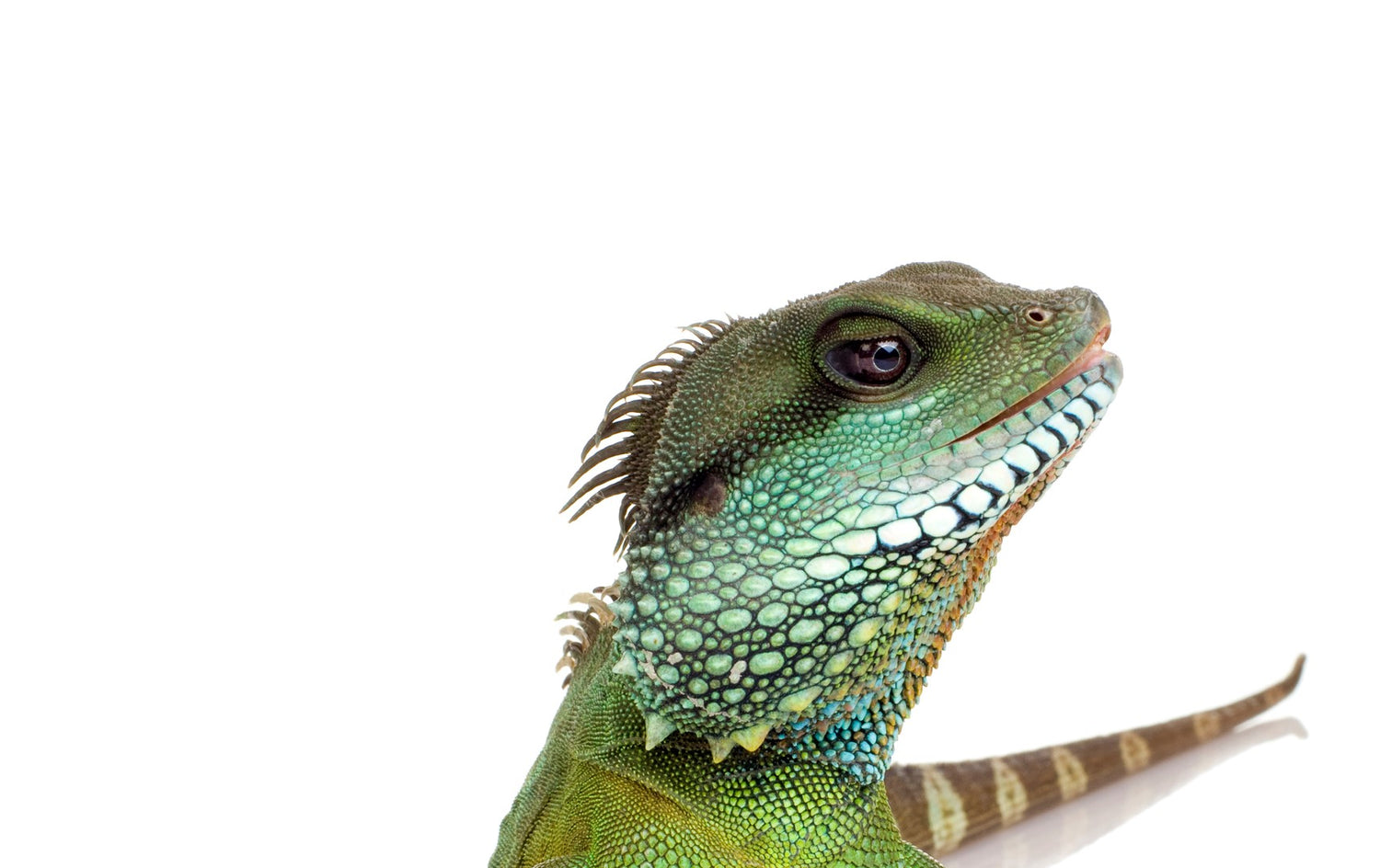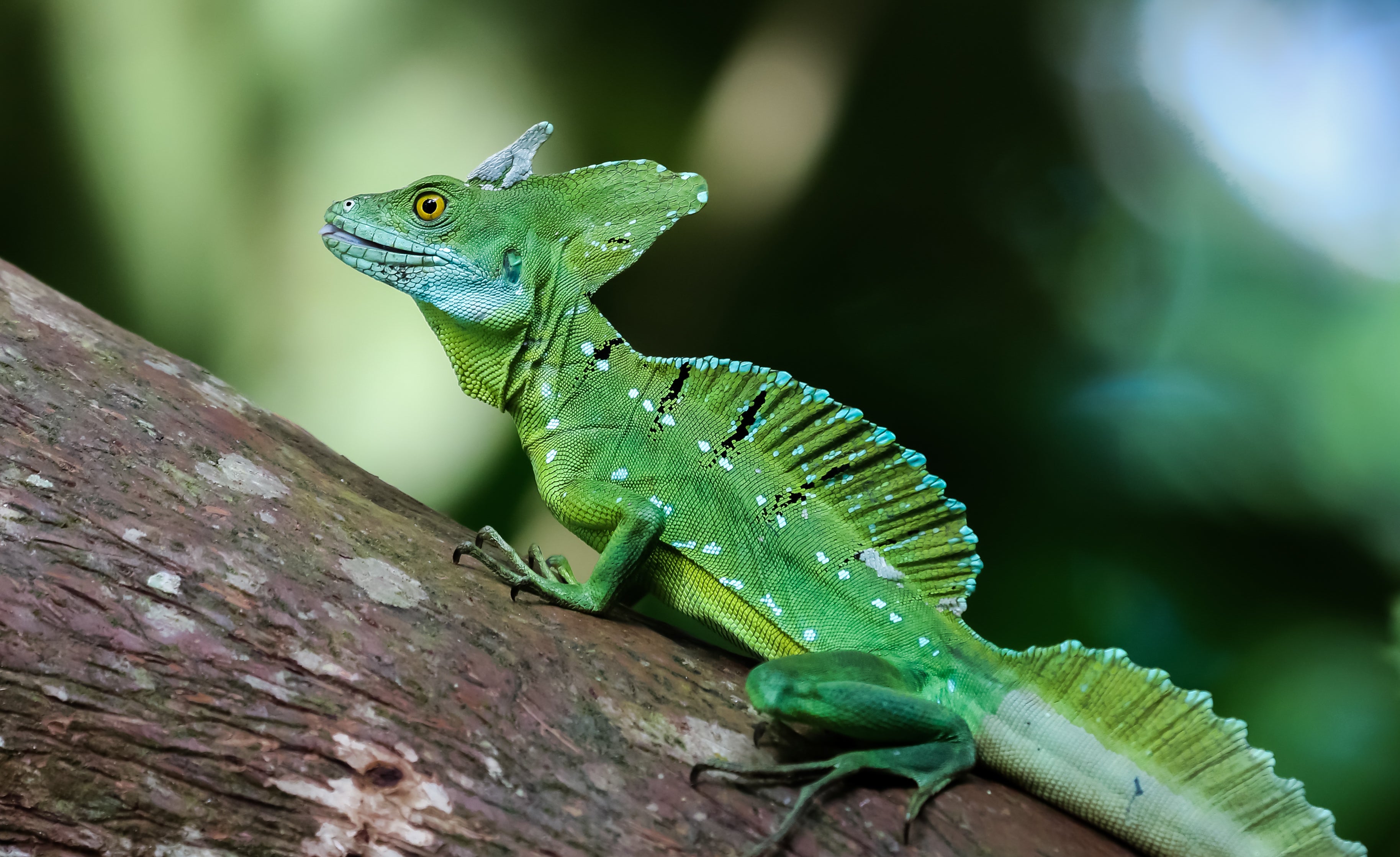Chinese water dragons (Physignathus cocincinus) are large, diurnal, arboreal lizards native to southeast Asia, where they can be found in tropical forested areas near freshwater lakes and streams. Adults can grow up to 3’ long, and they can live up to 15 years with good care.
Male Chinese water dragons have a large, crested head, a row of spines down their back, and prominent jowls. Females are plainer, but both have a vibrant green color with accents of brown, white, yellow, and/or aqua blue. They are often mistaken for iguanas.
Chinese water dragons are easy to find in pet stores, but they are not easy pets. They are large, require lots of preparation, and must be housed in a large enclosure with specialized equipment. They may or may not tolerate regular human interaction, depending on the individual.
How much space do Chinese water dragons need?
A single Chinese water dragon should be housed in no smaller than a 6’L x 3’W x 6’H enclosure. If at all possible, larger is strongly recommended. This size of enclosure is not typically available for purchase, so you will need to order one custom-made or build your own.
Cohabitation (keeping multiple Chinese water dragons in the same enclosure) is not recommended.
Do Chinese water dragons need UVB?
Chinese water dragons are diurnal, which means that they are most active during the day. It’s best to provide 13 hours of light during summer and 11 hours during winter. This simulates natural seasonal changes in day length and encourages healthier hormonal rhythms, similar to what they would experience in the wild.
UVB is required for Chinese water dragons to thrive in captivity. Aside from helping provide a day/night cycle and providing an infinite supply of vitamin D, UVB is also good for the lizard’s overall health. Chinese water dragons prefer a partial sun habitat, so you will need a low-intensity, high-quality source of UVB as part of the enclosure. Here are the best UVB bulbs for Chinese water dragons housed in a 6’L x 3’W x 6’H enclosure:
- Arcadia Desert 12%, 34”
- Zoo Med Reptisun T5 HO 10.0, 34”
If the UVB is mounted over mesh, place the basking branch 11-12” below the lamp. If the UVB is mounted inside the enclosure, place the basking branch 18-20” below the lamp. The UVB bulb should be housed in a reflective fixture and placed on the basking side along with the heat lamp. Make sure that the fixture your UVB bulb is housed in does not have a clear plastic bulb cover.
Since Chinese water dragons are active during the day, it’s beneficial to provide an additional daylight-spectrum lamp to make sure the enclosure is brightly illuminated. This is extra important since you will be using such a large enclosure. Use 3-4’ of strong 6500K LED or T5 HO fluorescent plant grow lights for best results.
What basking temperatures do Chinese water dragons need?
Chinese water dragons need a basking area temperature of 90-95°F and a cool side temperature between 75-80°F. Average temperature in the enclosure should stay between 77-86°F. Temperatures should be measured with digital probe thermometers, with probes placed on the basking spot and the floor on the cool side.
The basking surface itself should be a thick, sturdy wood branch placed near the top per the specifications listed previously.
Provide heat for your lizard by imitating the sun with a cluster of halogen heat lamps placed on one side of the enclosure. You will need enough lamps to evenly heat an area at least the size of the dragon’s body. Do not use ceramic heat emitters (CHEs), heat mats, red bulbs, or blue bulbs, as these are not as effective.
What humidity levels do Chinese water dragons need?
Chinese water dragons are a tropical species that needs a humid environment to stay healthy. Average humidity levels should be between 60-80%. Humidity should be measured with a digital probe hygrometer with the probe in the middle of the terrarium. Daily misting with a pressure sprayer and/or using a humidifier connected to a humidistat is helpful for maintaining high humidity.
Reptile humidifiers and foggers should only be used with distilled water and require frequent disinfecting to keep your reptile from getting sick.
Chinese water dragons naturally live near bodies of water in the wild, and they will dive into the water to escape potential predators. They are very comfortable in the water — they are excellent swimmers, can hold their breath for up to 25 minutes, and are known to even sleep in the water. For this reason, your pet will need its own “swimming pool.”
At very least, the pool needs to be 1/2 to 1/3 the length of the enclosure and large enough for them to completely submerge (at least 6” deep). Of course, deeper is better if you can provide it. Change out the water once weekly or whenever it gets soiled, and give the basin a good scrub with disinfectant before refilling. Using a siphon (or better yet, a mechanical water pump) and a hose will make emptying and refilling the pool much easier.
What substrate is good for Chinese water dragons?
Although Chinese water dragons spend a lot of time either climbing among branches or swimming down below, using substrate in the enclosure will cover the floor and help provide a cushion in the unlikely event that the lizard falls from its perch. It also helps maintain humidity!
We recommend the following substrates for Chinese water dragons:
You can even use a thick layer of fluffy, moistened sphagnum moss!
Substrate should be at least 4” deep and completely replaced every 3-4 months. Remove poop and urates daily, along with any contaminated substrate.
What decor can you use in a Chinese water dragon terrarium?
Chinese water dragons are well known for developing severe friction wounds on their nose from attempting to escape small, boring enclosures. One of the best ways you can help your pet be happy in its enclosure is to fill it with things for the dragon to use and interact with.
At bare minimum, you will need a sturdy basking branch, swimming pool, somewhere to hide, and a thick layer of substrate. However, it’s best to include other items, such as:
- additional climbing branches
- raised platforms
- hollow logs
- additional hiding places (dog/cat kennels can work well)
- live or artificial foliage
All climbing branches should be securely anchored into the walls/floor of the enclosure to prevent collapse.
What do Chinese water dragons eat?
Chinese water dragons are primarily insectivorous, which means that they need to eat a variety of insects to get the nutrition that they need. However, they are also known to eat small animals and small amounts of fruits and vegetation. However they need to eat varies depending on age:
- Hatchlings (<3 months old) — Insects daily
- Juveniles (<16” long) — Insects and salad every other day
- Subadults and adults (>16” long) — Insects every 3-5 days, salad daily
Offer as many insects as the lizard will eat via feeding tweezers in about 5 minutes.
Feeder insect options: crickets, discoid roaches, dubia roaches, earthworms, grasshoppers, hornworms, silkworms, mealworms, superworms, snails (captive-bred only)
Vegetable options: collard greens, cactus pads, spring mix, arugula, kale, alfalfa, bok choy, carrot greens, spinach, dandelion greens/flowers, hibiscus greens/flowers
Pinkies, fuzzies, live-bearing fish, and chopped fruit can be used as rare treats. Chinese water dragons can easily become overweight, so be sparing with the treats and reduce the portion size if your dragon is becoming too heavy.
Supplements
You will also need calcium and vitamin supplements to prevent your lizard from developing a deficiency. We recommend Repashy Calcium Plus LoD, lightly dusted on all insects.
Do Chinese water dragons like to be handled?
Truthfully, few reptiles actually “like” to be handled. Your Chinese water dragon may or may not tolerate handling well, depending on its individual personality. The key to building a trusting relationship with your pet is to provide as many positive interactions as possible. Offering food from feeding tweezers works well as an initial bribe, and it’s best to get the lizard to come to you rather than simply grabbing it.
When you start handling your Chinese water dragon, be gentle. Don’t grab the lizard from above, because that will make it afraid of you. Instead, approach from the side and scoop from below. Support as much of its body as possible, especially its feet. Start with very short handling sessions in the beginning, then gradually make them longer as your pet becomes more accustomed to you.
*This care sheet contains only very basic information. Although it’s a good introduction, please do further research with high-quality sources to obtain additional information on caring for this species.




Leave a comment
This site is protected by hCaptcha and the hCaptcha Privacy Policy and Terms of Service apply.